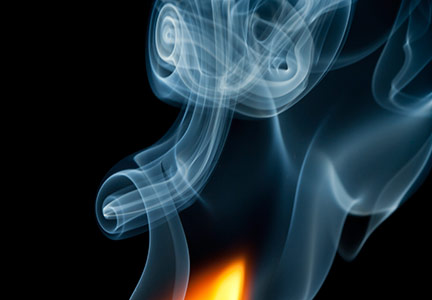In the movies, a mountain wildfire spreading out of control, destroying wood-frame homes and threatening innocent lives, may have the makings of a blockbuster filled with heart-wrenching drama, danger, tragedy, and fire-fighter action heroes charging in to save the day. However, when the movie ends, the viewer re-enters the real world. And in that real world, fire and the devastation it causes is as stark, real, and harmful as it gets for those unfortunate to be in its path. [Note: Ad or content links featured on this page are not necessarily affiliated with IICRC (The cleantrust) and should not be considered a recommendation or endorsement by IICRC (The cleantrust)].

Where there's fire, there's usually smoke. Although experts do their best to contain a fire, they are all but helpless in controlling the billowing clouds of smoke that fire creates. Prevailing winds can push this smoke hundreds of miles from its origin, blanketing distant communities with a dirty haze that can last for days, lowering air quality and creating a menace to civilization.
We know that smoke is not healthful to breathe, but what damage can smoke cause when it enters the interior of homes?
What is smoke?
Wood smoke contains tiny particles of often-carcinogenic material, water vapor, toxic gases and other volatile organic compounds. Some of the VOCs may include carbon monoxide, carbon dioxide, sulfur dioxide, nitrogen oxide, and formaldehyde.
Health Risks
Inhaling smoke-fouled air can increase the risk of developing many health problems. During normal respiration, many common particles, such as dust, are filtered out through the nose and sinuses. Yet, due to the abundance of hazardous materials found in wood smoke, filtering is much more difficult.
Breathing in wood smoke for a prolonged period of time can cause a scratchy throat, coughing, irritated sinuses, headaches, runny nose, stinging, irritated eyes, and worse. People with diseases such as chronic bronchitis, asthma, or other respiratory challenges may find symptoms worsening.
Damage To Homes and Property
During hot summer days, many people enjoy opening windows in the evening at bedtime to let fresh air in and give air conditioners a break, only perhaps to catch the scent of burnt wood when they awake the following morning. Unbeknownst to them, smoke has engulfed their area, entered their home, wafting from room to room, causing carpet, upholstered and other furniture, and apparel, to wreak of smoke. What can be done in this situation - or in the worst case scenario – after an actual fire in your home?
Odor Removal and Restoration
Using an indoor air filter or air purifier can help remove particles from the air and increase indoor air quality.
Getting that smoke smell out of clothing may require several cycles in a washer and dryer, or maybe a trip to the dry cleaners.
Removing the smoky odor from upholstered furniture and carpet is more challenging.
Restoration of property can be complex. Proper smoke and odor removal are tasks that may require special tools and techniques, and is often better left to restoration experts. IICRC recommends locating and using a cleantrust-certified restoration firm . They typically have formal and up-to-date specialized training and tools, experience in a wide range of restoration projects, and proof of proper insurance and licenses.
By choosing a cleantrust-certified professional, you can often completely vanquish and remove smoke odor, and cope with related water damage – restoring your home back to its healthy, safe, pre-fire and -smoke condition.









